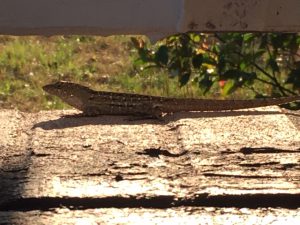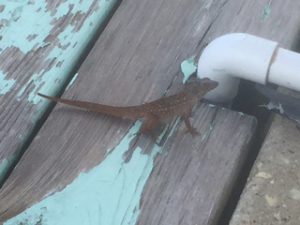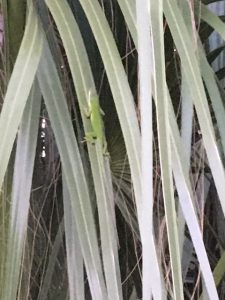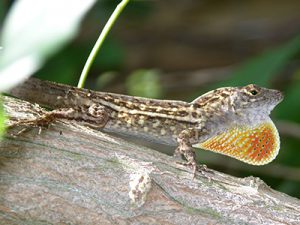Check out this guy…
We found him last week on our front porch, basking in the sun.
It is a Cuban Anole… an invasive lizard.

Photo: Rick O’Connor
As the name suggests, the Cuban Anole (also called the Brown Anole – Anolis sagrei) is from Cuba – and is also native to the Bahamas. You might recall from Lesson 1, there are three characteristics we use to label a species as “invasive”. #1 being they are non-native; Cuban Anoles are non-native.
#2 – They had to have been brought to the area by humans – whether intentionally or not.
It is believed this lizard hitched a ride on a boat from Cuba to southern Florida – so arrived by accident. Some date it’s introduction as far back as the 1880s, but it has been here a long time. Finding south Florida’s climate to its liking, it began to reproduce in large numbers. It is a ground dweller and moves across the landscape searching for food, which includes things like spiders and insects.
Over time, they have slowly migrated north into central and north Florida. They have also hitched rides on trucks carrying ornamental plants grown in south Florida. I have personally visited a local nursery that has several greenhouses to protect plants that do not want full sun. One of those was so invested with the lizard, as you walked in hundreds began to run across the ground and over the tables – they must have come in with a shipment.

Photo: Patty Barker
#3 – They must be causing either an environmental, or economic problem.
In this case it is environmental. Being invasive, Cuban anoles reproduce in great numbers. Where they arrive, they quickly become very abundant. I just mentioned the story of the local nursery. Prior to Hurricane Michael I remember making stops at rest areas along Interstate 10 heading to Gainesville. Not one of them was free of this lizard. Possibly introduced on landscaping plants, they were very abundant. As you walked to the restroom you could see them scattering and running everywhere across the ground.
In Gainesville there are raised beds surrounding the trees that circle the outside of the football stadium. Glancing in each one you would find numerous Cuban anoles scattering all over.
But are high numbers a problem?
For some, yes. It is like walking outside and seeing numerous cockroaches scattering across the yard. It is just un-nerving to some people. Some scientists believe this should be an additional characteristic of an invasive species… “reduces your quality of life”.

Photo: Rick O’Connor
In this case though – there is another environmental problem… competition with the native Green Anole (Anolis carolinensis). Most of us are familiar with this local lizard. Many call it “the chameleon” because of its habit turning brown and green – even dark brown/black – to match its surroundings. It is not a chameleon at all but, like the Cuban Anole, more closely related to iguanas. It differs from the Cuban anole in that (1) it can change color – the Cuban anole cannot, (2) the snout is longer than the Cuban Anoles, (3) though the female green anole may have a white stripe running down the middle of her back, she will not have the yellow/white patch/diamond looking markings found along the sides of the Cuban anole – these side (lateral) markings can include grey and black as well. (4) the dewlap of the male Green anole is pink in color; the male Cuban anole’s will be red-orange and have a white line outlining the bottom.
For those who do not know – the dewlap is a flap of skin beneath the throat that the males expose as a territorial display. They will bob their heads several times and then expose this dewlap when the encounter another male (read more about territoriality in Wildlife Lesson 1).
When the

Photo: Jerry Patee
Cuban anole is introduced to a habitat where the Green anole already exists, the competition begins. The Green anoles are often forced higher in the shrubs, trees, and buildings – Cuban anoles are not great climbers. However, once Green anoles are “up there” they have fewer resources and fewer opportunities for breeding. They will usually move to another neighborhood or begin to die off from the lack of resources. Cuban anoles are also known to consume the eggs and young of the Green anoles. So, we see a decline of the native and an increase of the non-native.
So, what do we do?
#1 – Be careful when buying plants from nurseries and stores. Check to make sure there are no “friends” are riding home with you on your plants.
#2 – Report any Cuban anoles to https://www.eddmaps.org/. We explained how to get an account for this in Invasive Species Lesson 1. It is pretty easy – and important. Currently EDDMapS is saying there is (1) record from Gulf Breeze, (3) from Navarre Beach, (1) from Milton, and (7) from Ft. Walton Beach. It appears it is not widespread here – but in fact it is. I know there are many of these in Gulf Breeze, Perdido Key, and Innerarity Point. I also know they are becoming more common in East Hill/Pensacola. I will be reporting this one today.
#3 – Removing them…
This is hard this time of year. Cuban anoles are very fast and hard to catch. The best time is winter when they slow down. IF you catch one, you can place a little benzocaine on their backs. This will numb their nervous system so they do not feel pain, and then you can freeze them. Some folks will have a hard time killing one. I get it. But also know that managing invasive species is important. Going back to #1 in this list, and keeping them from reaching your yard, is the best method.
ACTIVITY
So now let’s do an activity…
1) Go on to EDDMaps.org – select Wildlife – select Reptiles – type in Brown Anole in the search box – select Points – to see where the lizard has been reported in our area. This will give you practice using this website. You can zoom into each one – see where it was reported – maybe a photo.
2) Roam through your yard and see if you can find one. They are going to be around pots, flowerbeds, under logs and rocks, and will eventually come out to bask in the sun to warm up. Get a photo and then report it on EDDMapS. It will be your call whether to remove the animal or not.
3) I know many of you reading this are not from Florida – I recommend doing the same activity with another invasive species from your area. Your parents may have a good idea of which, or you can search some on EDDMapS.org.
HOMEWORK
I have two homework assignments today… yep… homework…
1) Take at least three small clear drinking glass and fill them about 75% full of water. In one place something inorganic – like sand, sugar, salt, you have as many glasses as you want. In other place something organic – like a leaf, grass, seeds. In the third place something man-made – like a nail, screw, pin, coin. Again, you can have as many glasses and items as you would like. Place them somewhere out of the way and we are going to watch them dissolve. We will come back to this each Wednesday.
2) Rake at least five piles of leaves in your yard. They do not have to be real big piles, just separate them for future lessons in habitat. Try to get those today because it will rain tomorrow (in Pensacola) and that will help “cook” the system.
More soon. Have fun outside. Stay safe.
 2
2
